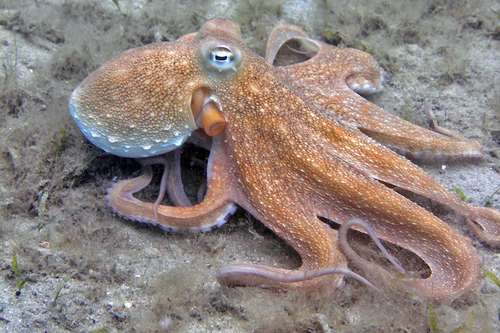
Description:
Scientific Name: Octopus briareus
Lifespan: a year to a year and a half
A marine creature found on coral reefs is the Caribbean reef octopus (Octopus briareus). It features eight long, varying-length, varying-diameter arms. In contrast, the mantle is big and bulky (up to 60 cm long). This species, which uses specialist skin cells called chromatophores, is challenging to explain since it alters its colour and texture to blend in with its environment. It has a wide spectrum of colours and can go from red to green as well as from bumpy to smooth. It is 1.5 kg or around 3.3 lb in weight.
Caribbean reef octopuses have bright green and blue bodies with reddish-brown patches all over them. Thanks to chromophores, which are specialised cells in the skin, these octopuses can alter their colour to fit in with their surroundings, hide from predators, and catch prey. These octopuses have noticeable, large, dark red-brown eyes. Caribbean reef octopuses have a total of seven rows of teeth. These octopuses’ longest arms, the second and third, stretch on average five times longer than the mantle.
Habitat
Octopus briareus, often known as the Caribbean reef octopus, is primarily found in warm, Neotropical waters. The range of this species spans southern Florida in North America, the Bahamas, the Caribbean, and the southeast Gulf of Mexico coast before descending south to the northern coast of South America. Also seen in the West Indies and off the coast of Curaçao are Caribbean reef octopuses. Caribbean reef octopuses typically live on or near coral reefs, which they use as dens and places of safety.
Behavior
The octopuses in the Caribbean reef live alone. They only interact with other animals during mating, staying alone in dens among coral reefs. These octopuses are territorial and protect their den and the area around it from predators and other octopuses. Within their area, they have the ability to devour and kill other octopuses. The darkness shields nocturnal Caribbean reef octopuses from predators and makes it simpler for them to sneak up on prey.
Octopuses have only one female and one male mate, making them monogamous. The octopuses in Caribbean reefs are not known to have a mating ritual. In order for the female to store and use the sperm when the eggs are ready for internal fertilization, the male either mounts the female or removes its hectocotylus and gives it to the female.
Octopuses living on Caribbean reefs have a variety of techniques to interact with one another. These organisms are able to interact with one another thanks to a sender-receiver match (a species-specific vocalization). The chromatophores on an octopus’ skin are used to create intricate patterns that other octopuses can recognise. These octopuses also communicate with other octopuses by reflecting light off layers of iridocytes deep within the dermis of their skin.

Keeping as a Pet/ In Captivity
Aquariums can house the Caribbean Reef Octopus. If you decide to get one as a pet, you’ll need a tank that’s about average in size, holding at least 50 gallons and ideally 75 gallons. Given that this species lives in shallow waters and loves warmer water, it is advisable to maintain warm water in your tank, at a temperature of about 78°F.
Your pet Caribbean Reef Octopus will value some coral reef decorations or stones that it can utilize as hiding places because the reef is its native home. To provide your pet a more stimulating habitat, feel free to add decorations to your tank that have a variety of colors and textures.
The Caribbean Octopus typically emerges at night to eat fish that are dozing or small crustaceans. It brings the catch to its mouth, which resembles a beak, using its eight tentacles.
If given a lot of live rock, places to hide, and space to move around in the aquarium tank, the Caribbean Octopus will thrive there. It favours aquariums with caves and coarse to medium substrate that have low illumination levels. Dim, photochemical active (actinic) lighting is the best kind of lighting for this aquarium.
Table





